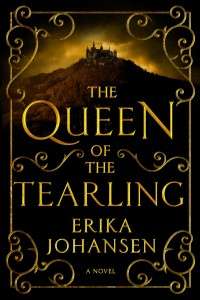The Queen of the Tearling
Erika Johansen
HarperCollins Publishers
Release Date: July 8, 2014
ISBN 978-0-06-229036-6
The Queen of the Tearling is a wonderful debut novel by Erika Johansen. It is a fantasy – the first of a trilogy – that is set in the “real” world, albeit one that hearkens to a medieval past. There are no elves or dwarves in Ms. Johansen’s story, but there is a good queen pitted against an evil queen, and knight-like guards and a charming King of Thieves. And there is magic. Not a lot of magic, for this is not a realm of sorcerers and wizards, but magic does play a part in the lives of those who know how to wield it – or who have been bestowed with items imbued by magic, if they are strong enough to use them.
But what sets this fantasy apart is the central character: Kelsea, a young woman who has been sequestered since birth, raised in secret to ascend to the throne of the Kingdom of Tear on her 19th birthday. Kelsea’s own mother, Queen Elyssa, had died – possibly assassinated – many years before and the country had been in the hands of her weak-willed and debauched younger brother, named as Regent.
Although raised to be literate and intelligent by former Queen’s Guard and herbalist Barty (a loving and jolly fellow) and his rather stern and exacting wife Carlin, with knowledge of the demands to be placed on her once she achieved her majority as well as the corresponding threats and dangers, nothing could truly prepare Kelsea for the day the riders came to take her to the Keep in New London to claim the throne. Even the trip from the cottage in the woods that she had called home to the Keep in the capital city was done in stealth and with all speed, for it was not only the Regent who wanted to keep her from the throne – the Red Queen in the neighboring kingdom of Mortmesne had long pulled the puppet strings of the Tearling Regent and even the Queen before him, and was not welcoming of a change in leadership.
Beyond that, Kelsea is Queen in name only until she is able to prove herself, starting with the very men who have been tasked with delivering her safely to New London. Having been raised in obscurity, she lacks the procedural acumen that would have granted her confidence in knowing the right demeanor to hold, or the correct responses to give, even as events occur immediately upon leaving her childhood home. But Kelsea is quick witted and pragmatic, and it’s not too long before she begins to win a grudging respect from her guards. Also, they all are sworn to protect the Queen, whoever she may be, and their leaders, the honorable Carroll and the fearsome Lazarus (also known as the Queen’s Mace, or head enforcer) are ironclad in their dedication to those vows of obedience.
Still, making it to New London is not the end of Kelsea’s journey. Not only must she engender loyalty, but she must sidestep continual assassination attempts from not just hired mercenaries, but also from within her own realm. Haughty lords who had grown fat and complacent over the power their money had bought them, the dictatorial God’s Church which vied for fealty of the peasants, and a corrupt government agency known as the Census all wanted her controlled, if not dead. And then there is that charming King of Thieves…
Ms. Johansen does an admirable job in crafting a tale of adventure and courage, of intrigue and honor, filled with creations both familiar and otherworldly. Her tale flows effortlessly, and just as Kelsea finds herself borne along with the actions and reactions made necessary by her ascendency (and her survival), we are kept entertained by how relentlessly the story moves forward; there is very little lag here, and what introspection is allowed the young Queen is exactly what we need in order to understand this new world.
But the most exciting thing about this book, and the potential in the books to follow, is the character of Kelsea herself. Here is a heroine that feels real: a young woman who is unremarkable except by the virtue of her birth, who is neither skilled with a blade nor endowed with superior abilities – she is not even especially attractive. Her face is undeniably plain (no false modesty here!), and her body is soft; she tends to eat too much and her bearing reflects that. She has a temper which has gotten her into trouble with Carlin many times in her growing years, and threatens to undermine her when diplomacy gets tiresome. She is intelligent, but that has as much to do with having a modest library of books at her disposal as she grew and a stern taskmaster as a mother figure rather than some keen, innate ability to see more deeply or more clearly than others.
Yet what she does possess is a caring nature, a deeply rooted morality and a desire to be a good Queen – all of which have been sorely absent in the royalty of the Tearling for decades. Kelsea is determined to be a good Queen for her people – all her people – if she can only live long enough to do so.
The only drawback I found in reading The Queen of the Tearling was Ms. Johansen’s attempt at a backstory for her created world. While the geography is unfamiliar and the setting is definitely primitive, it is made clear that the Tearling and the surrounding lands of Mortmesne and Cadare (which all together are only about as large as the state of Georgia) have arisen after some cataclysmic events that have devastated our own world. The implication is that there has been some sort of technological disaster on a global scale, but there are no telltale dystopian hints of what might have happened, no leftover remnants of any previous civilization. Tearling history speaks of “the Crossing” over what is known as God’s Ocean centuries earlier; indeed, the very books that Kelsea reads as a child came across from this ancient land, from that other time: Tolkien, Rowling, the Bible (she even references books by historian Barbara Tuchman).
But there are other inconsistencies that are even harder to reconcile. For instance, there are no doctors in Tearling, because the one ship that contained all the doctors and all the medical knowledge and equipment left in the world was sunk on the crossing from America. One ship? And in the centuries since, there has been no appreciable gain in medical knowledge in this new land? There likewise is a thirst for knowledge in Tearling, but even though the concept of a printing press is familiar, none currently exist, and apparently no one in hundreds of years has been able to replicate one. There are even more bizarre disparities, such as mention that purple cloth is extremely rare because no one has unlocked the secrets of that color of dye (in centuries?) and yet later there is mention of a high born lady utilizing purple nail polish. If they can create a purple nail polish, why can’t they figure out how to create purple dye for clothing? Seems like fabric dye would be easier to manufacture than fingernail polish.
Still, Ms. Johansen relates these apparent paradoxes with an innocence and naivety that allow them to slip by with only an occasional furrowed brow on the part of this reader, at least. I am willing to cede to her somewhat peculiar world history if it means I can continue reading the captivating saga of Kelsea Raleigh Glynn and those who choose to stand with her. Maybe the questionable past of the world before will become clearer in the ensuing books of the trilogy. Then again, maybe not.
In the end, it’s not a deal breaker for me. To be honest, I’m more interested in what becomes of the that charming King of Thieves, and what role he will play in Queen Kelsea’s continuing story.

